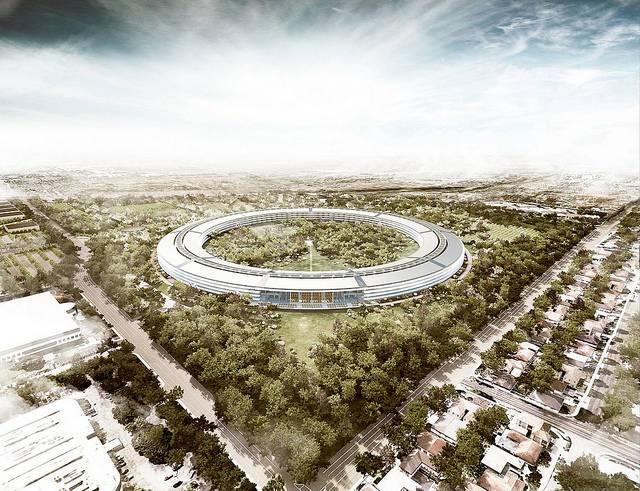
Apple is close to opening its new headquarters in Cupertino, California. Employees will start claiming their spaces within 30 days, but the entire process of consolidating everyone under one roof could take up to six months.
The excitement is certainly buzzing for this Silicon Valley gem. Two miles of walking paths crisscross the new campus, and those burned calories can be canceled out by pizza delivered in next-gen boxes that will spare employees the annoyance of a soggy pie.
But Apple's new campus is curiously missing a few things -- one being daycare facilities. As Quartz writer Mike Murphy surmised, that omission is “probably not a big deal to workers who don’t need to leave the 'mothership' to tend to such worldly pursuits as child-rearing.”
The 175-acre campus, which is about one mile in diameter, also does not offer easy access to public transit. What employees do have is the choice to leave their cars in one of the 11,000 onsite parking spaces.
One could argue that forcing employees to drive is not necessarily Apple’s fault. The nearest train station is about five miles away in Sunnyvale; and most likely no one will be bothered to take a bus down Stevens Creek Boulevard and then take a lengthy walk to what many call the “spaceship.”
As Jason Henderson, a San Francisco State University professor who focuses on transportation, told a local radio station last month: “They’re going to generate a lot of emissions if you consider many of the moving pieces here, including that this facility is located very far from any mainline public transportation.”
What Apple’s shiny mothership lacks, in the eyes of some critics, turns out to be a missed opportunity to show that it really is a 21st-century company willing to meet the needs of all of its employees.
The median home value in Cupertino, once a blue-collar town known more for good schools and an impressive collection of public parks, has now soared to over $1.8 million, according to Zillow. Even though the city of 60,000 is adding more housing and mixed-use developments, it is doubtful than few employees other than the company’s highest-paid managers and executives can afford to live there. The company says it will rely on private shuttles, but considering Google’s experience with such a system in the past, it is hard to argue that a company fleet is a long-term solution.
And the lack of daycare shows a degree of tone-deafness considering that critics have long attacked the technology sector for falling far short when it comes to diversity. Add the “motherhood penalty” that often gets in the way of career advancement, and one wonders why some space in the 2.8 million square-foot facility could not have been reserved for a daycare center (a 100,000 square-foot gym, however, is available to all employees).
The campus, which is located on land once occupied by leading Silicon Valley names such as Hewlett-Packard and Tandem, does showcase many impressive features. Apple says it will plant as many as 9,000 trees around the massive ring-shaped structure, a project that will recall a time when Cupertino was known for its apricot and plum orchards.
The building itself promises to be energy efficient, with a 17-megawatt solar array promising to meet most of the headquarters’ power requirements. And instead of a conventional HVAC system, the building’s design allows it to draw air from the outside and circulate around the entire building, replicating the Santa Clara Valley’s near-perfect weather that is probably only outdone by San Diego.
One could say that a focus on what the new Apple building does not offer, instead of highlighting what is progressive about this new campus, is unfair. Indeed, working within the Apple’s new digs will be a singular experience compared to the drab office parks that line Silicon Valley streets such as Lawrence Expressway or Tasman Drive.
But what is lacking is surprising. After all, consumers have flocked to Apple’s products for years for their user-friendly features. Telling workers they have to rely on the automobile, along with implying that women can forget about any semblance of work-life balance, smacks as more 20th-century thinking than genuinely looking ahead.
Image credit: Mark Mathosian/Flickr

Leon Kaye has written for 3p since 2010 and become executive editor in 2018. His previous work includes writing for the Guardian as well as other online and print publications. In addition, he's worked in sales executive roles within technology and financial research companies, as well as for a public relations firm, for which he consulted with one of the globe’s leading sustainability initiatives. Currently living in Central California, he’s traveled to 70-plus countries and has lived and worked in South Korea, the United Arab Emirates and Uruguay.
Leon’s an alum of Fresno State, the University of Maryland, Baltimore County and the University of Southern California's Marshall Business School. He enjoys traveling abroad as well as exploring California’s Central Coast and the Sierra Nevadas.














